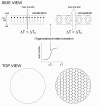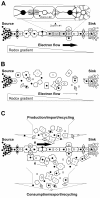The self-organizing fractal theory as a universal discovery method: the phenomenon of life
- PMID: 21447162
- PMCID: PMC3080324
- DOI: 10.1186/1742-4682-8-4
The self-organizing fractal theory as a universal discovery method: the phenomenon of life
Abstract
A universal discovery method potentially applicable to all disciplines studying organizational phenomena has been developed. This method takes advantage of a new form of global symmetry, namely, scale-invariance of self-organizational dynamics of energy/matter at all levels of organizational hierarchy, from elementary particles through cells and organisms to the Universe as a whole. The method is based on an alternative conceptualization of physical reality postulating that the energy/matter comprising the Universe is far from equilibrium, that it exists as a flow, and that it develops via self-organization in accordance with the empirical laws of nonequilibrium thermodynamics. It is postulated that the energy/matter flowing through and comprising the Universe evolves as a multiscale, self-similar structure-process, i.e., as a self-organizing fractal. This means that certain organizational structures and processes are scale-invariant and are reproduced at all levels of the organizational hierarchy. Being a form of symmetry, scale-invariance naturally lends itself to a new discovery method that allows for the deduction of missing information by comparing scale-invariant organizational patterns across different levels of the organizational hierarchy.An application of the new discovery method to life sciences reveals that moving electrons represent a keystone physical force (flux) that powers, animates, informs, and binds all living structures-processes into a planetary-wide, multiscale system of electron flow/circulation, and that all living organisms and their larger-scale organizations emerge to function as electron transport networks that are supported by and, at the same time, support the flow of electrons down the Earth's redox gradient maintained along the core-mantle-crust-ocean-atmosphere axis of the planet. The presented findings lead to a radically new perspective on the nature and origin of life, suggesting that living matter is an organizational state/phase of nonliving matter and a natural consequence of the evolution and self-organization of nonliving matter.The presented paradigm opens doors for explosive advances in many disciplines, by uniting them within a single conceptual framework and providing a discovery method that allows for the systematic generation of knowledge through comparison and complementation of empirical data across different sciences and disciplines.
Figures




Similar articles
-
Life, hierarchy, and the thermodynamic machinery of planet Earth.Phys Life Rev. 2010 Dec;7(4):424-60. doi: 10.1016/j.plrev.2010.10.002. Epub 2010 Oct 12. Phys Life Rev. 2010. PMID: 20970394 Review.
-
Human development VII: a spiral fractal model of fine structure of physical energy could explain central aspects of biological information, biological organization and biological creativity.ScientificWorldJournal. 2006 Nov 14;6:1434-40. doi: 10.1100/tsw.2006.256. ScientificWorldJournal. 2006. PMID: 17115083 Free PMC article. Review.
-
Biogeochemistry of dihydrogen (H2).Met Ions Biol Syst. 2005;43:9-48. doi: 10.1201/9780824751999.ch2. Met Ions Biol Syst. 2005. PMID: 16370113 Review.
-
The similarity of life across the universe.Mol Biol Cell. 2016 May 15;27(10):1553-5. doi: 10.1091/mbc.E15-11-0809. Mol Biol Cell. 2016. PMID: 27255694 Free PMC article.
-
The fractal geometry of life.Riv Biol. 2009 Jan-Apr;102(1):29-59. Riv Biol. 2009. PMID: 19718622 Review.
Cited by
-
Fundamental awareness: A framework for integrating science, philosophy and metaphysics.Commun Integr Biol. 2016 May 12;9(3):e1155010. doi: 10.1080/19420889.2016.1155010. eCollection 2016 May-Jun. Commun Integr Biol. 2016. PMID: 27489576 Free PMC article. Review.
-
Fractal dimension of chromatin: potential molecular diagnostic applications for cancer prognosis.Expert Rev Mol Diagn. 2013 Sep;13(7):719-35. doi: 10.1586/14737159.2013.828889. Expert Rev Mol Diagn. 2013. PMID: 24063399 Free PMC article. Review.
-
Connect and Conquer: Collectivized Behavior of Mitochondria and Bacteria.Front Physiol. 2019 Mar 29;10:340. doi: 10.3389/fphys.2019.00340. eCollection 2019. Front Physiol. 2019. PMID: 30984025 Free PMC article.
-
Heterogeneous Heat Absorption Is Complementary to Radiotherapy.Cancers (Basel). 2022 Feb 11;14(4):901. doi: 10.3390/cancers14040901. Cancers (Basel). 2022. PMID: 35205649 Free PMC article. Review.
-
Primal eukaryogenesis: on the communal nature of precellular States, ancestral to modern life.Life (Basel). 2012 Jan 23;2(1):170-212. doi: 10.3390/life2010170. Life (Basel). 2012. PMID: 25382122 Free PMC article.
References
-
- Vermeij GJ. Nature: An Economic History. Princeton, NJ: Princeton University Press; 2004.
-
- Nicolis G, Prigogine I. Self-organization in Nonequilibrium Systems. New York: John Wiley & Sons, Inc; 1977.
-
- Prigogine I, Stengers I. Order out of Chaos. Man's New Dialogue With Nature. New York: Bantam Books; 1984.
-
- Winfree AT. Spatial and temporal organization in the Zhabotinsky reaction. Adv Biol Med Phys. 1977;16:115–136. - PubMed
Publication types
MeSH terms
Substances
Grants and funding
LinkOut - more resources
Full Text Sources

